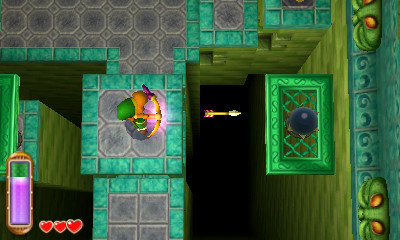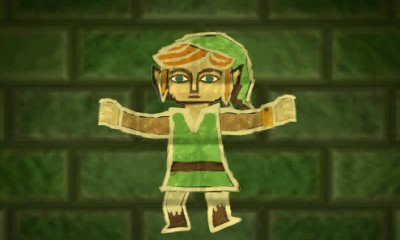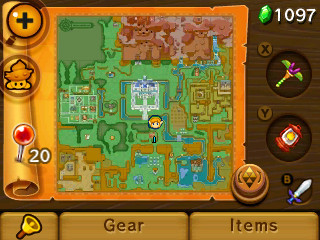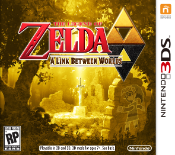Good review--it's one of the few I've read that doesn't fall over itself praising the game. I haven't played it yet, but thought it seemed kind of "samey" as well. That said, I'm surprised you were so impressed with the graphics--it's usually the one thing that is (softly) criticized, although the 3-D is superb.
The Legend of Zelda: A Link Between Worlds Review
|
|
See PixlBit's Review Policies

On 02/09/2014 at 12:00 PM by Julian Titus Just another Zelda game. Or is it??? |

Old and new fans of the Zelda series need to play this.
I am not a Zelda fan. Even in the early days, the series never really grabbed me. Oh, I played the original Legend of Zelda and its immediate sequels/prequels for the NES and SNES respectively. Other than that first game and Link’s Awakening on the Game Boy, the many entries in the franchise have never held me long enough to finish them. And I’ve tried. Oh, how I’ve tried! So based on what you’ve read, you would probably assume that I’m the worst person to review The Legend of Zelda: A Link Between Worlds on this website. Maybe you’re right, but I think I’m the best person to write this review because of my lukewarm reception to the series. So let’s move on and see who’s right, shall we?
A Link Between Worlds is a direct sequel to the fabled SNES title, The Legend of Zelda: A Link to the Past (we just called it Zelda 3 back then). It’s also somewhat of a spiritual successor/remake, taking place on virtually the same map as the original game. While that makes sense in the context of the story (places don’t really change that much over a couple hundred years, after all), there’s almost something laughable about Nintendo—a company criticized for making this series a bit too “samey” as of late—blatantly reusing so much of a previous game. While there are plenty of new things to see and places to visit, as someone who was around when A Link to the Past came out I couldn’t help but feel a sense of “been there, done that” as I traversed Hyrule.
Yes, there’s a pervading sense of déjà vu throughout Link’s first foray on the 3DS, but I’m willing to let that slide. I’m a sucker for nostalgia, and the folks at Nintendo are the masters of repackaging fond memories and putting a nice spin on them. A Link Between Worlds manages to tickle that part of my heart that remembers sitting way to close to the TV with my SNES pad in hand, while simultaneously creating the most modern Zelda game in fifteen years.
This is accomplished by letting players roam the country sides of Hyrule and its dark twin, Lorule with almost total freedom. After a mercifully brief period where the game puts the training wheels on, this portable Zelda adventure is open for exploration and experimentation. Yes, dungeons still largely hang on the need for specific tools to conquer, but all of the items in the game are easily rented for a small fee at a shop. This eliminates that traditional Zelda formula of beating the first temple which has the bombs, which in turn allows you to beat the second temple that has the bow, so on and so forth. There was something magical about walking around, looking for hidden goodies like heart container pieces and rupee treasure troves, only to come across a dungeon in need of solving. It’s the most freedom I can remember the series having since those first couple of games, and in looking to the past Nintendo may have unlocked the future of the Zelda franchise.
A couple sticking points from modern Zelda games persist, keeping A Link Between Worlds from being the game changer that it could have been. Even though the tutorial section is over quickly, the game tends to coddle players in the way that Skyward Sword was criticized for. All of the dungeons are marked on your map, taking a lot of the sense of discovery away from the exploration. The items you need to solve puzzles are almost always explicitly indicated in the décor of each labyrinth. It’s hard to feel satisfied overcoming a brain teaser when the symbol for the item needed is right next to the solution.
If there’s a place where thinking outside the box is rewarded, it would be with the “painting” mechanic. Link gains the ability to merge onto virtually any surface, becoming a two dimensional painting. This allows him to slip through cracks, traverse wide gaps, and a plethora of other ingenious applications. What could very easily have been a shallow gimmick becomes an expertly crafted addition to the familiar 16-bit Zelda game. The best puzzles in the game revolve around turning Link into 2D, which may or may not be Nintendo’s way of acknowledging the fact that Zelda is at its best in its classic overhead configuration.
While that overhead perspective may seem like a retread and even quaint, the execution is anything but. This is by far the best looking game I’ve seen on the 3DS so far. The colors are bright and vibrant, the environments a deceptively simple polygonal rendition of the classic SNES sprites. Even the squatty character models manage to exude a level of detail and personality that I typically associate with the “Wind Waker style” games. Screenshots don’t do this game justice; you need to see it in action for yourself.
Taken on its own, the game looks fantastic, but turning the 3D slider all the way up brings the look of the game to new heights. This is the best use of 3D I’ve seen so far, and that goes beyond the 3DS platform. The dungeons are designed with a sense of verticality that makes those precarious perches seem even more dizzying when 3D is on. While having the slider turned up isn’t mandatory for solving puzzles, it does make the environments pop in a way that makes everything easier to differentiate. Unless your eyes can’t process 3D images or you own a 2DS I strongly recommend having 3D enabled all the time. Just don’t forget to rest your eyes.
If The Legend of Zelda: A Link Between Worlds is a visual triumph, it is also an audio masterpiece. While the franchise has had memorable tunes since the outset, the music in this spiritual successor takes things to the heights of aural ecstasy. By using new orchestrations that weave the classic 16-bit soundtrack with bits of modern Zeldas and original compositions, the themes of this game will stay with you long after you’ve saved Hyrule. Like the classic Zeldas of yore, these tracks are just as enjoyable from minute one as they are fifteen looped hours later.
I do have some issues with Nintendo cashing in on my nostalgia this blatantly, and A Link Between Worlds plays things a little too safely at times. The dungeons are rather easy to solve, especially with the hints all over the place, and many of the environments are so faithfully recreated that it can sometimes be easy to lose sight of all the new stuff found within. However, this is a delightful Zelda adventure that, by sheer nature of its predecessor, never wears out its welcome with its compact design. This isn’t the game changer that the series needs, but there are ideas here that Nintendo would do well to iterate on for that inevitable Wii U game.
Of course, they could just make another 3DS game of this quality and that would suit me just fine.














Comments